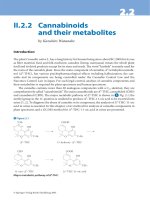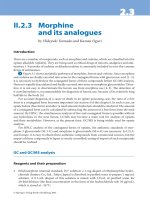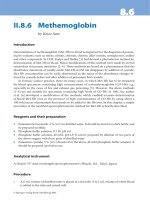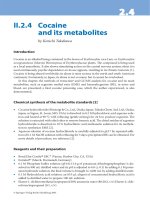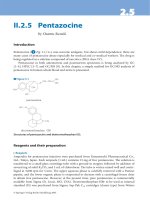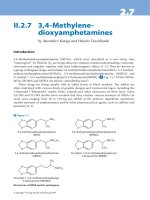..GENE CLONING AND DNA ANALYSIS..GENE CLONING AND DNA ANALYSISAn IntroductionT.A. BROWNFaculty of Life Sciences University of Manchester ManchesterSixth EditionA John Wiley & Sons, Ltd., Publication. pdf
Bạn đang xem bản rút gọn của tài liệu. Xem và tải ngay bản đầy đủ của tài liệu tại đây (13.17 MB, 338 trang )
9781405181730_1_pre.qxd 1/11/10 10:23 Page iv
GENE
CLONING
AND DNA
ANALYSIS
9781405181730_1_pre.qxd 1/11/10 10:23 Page i
9781405181730_1_pre.qxd 1/11/10 10:23 Page ii
GENE
CLONING
AND DNA
ANALYSIS
An Introduction
T.A. BROWN
Faculty of Life Sciences
University of Manchester
Manchester
Sixth Edition
A John Wiley & Sons, Ltd., Publication
9781405181730_1_pre.qxd 1/11/10 10:23 Page iii
This edition first published 2010, © 2010, 2006 by T.A. Brown
First, second and third editions published by Chapman & Hall 1986, 1990, 1995
Fourth and fifth editions published by Blackwell Publishing Ltd 2001, 2006
Blackwell Publishing was acquired by John Wiley & Sons in February 2007. Blackwell’s
publishing program has been merged with Wiley’s global Scientific, Technical and
Medical business to form Wiley-Blackwell.
Registered office: John Wiley & Sons Ltd, The Atrium, Southern Gate, Chichester,
West Sussex, PO19 8SQ, UK
Editorial offices: 9600 Garsington Road, Oxford, OX4 2DQ, UK
The Atrium, Southern Gate, Chichester, West Sussex, PO19 8SQ, UK
111 River Street, Hoboken, NJ 07030-5774, USA
For details of our global editorial offices, for customer services and for information about
how to apply for permission to reuse the copyright material in this book please see our website
at www.wiley.com/wiley-blackwell
The right of the author to be identified as the author of this work has been asserted in
accordance with the Copyright, Designs and Patents Act 1988.
All rights reserved. No part of this publication may be reproduced, stored in a retrieval
system, or transmitted, in any form or by any means, electronic, mechanical, photocopying,
recording or otherwise, except as permitted by the UK Copyright, Designs and Patents Act
1988, without the prior permission of the publisher.
Wiley also publishes its books in a variety of electronic formats. Some content that appears in
print may not be available in electronic books.
Designations used by companies to distinguish their products are often claimed as trademarks.
All brand names and product names used in this book are trade names, service marks, trademarks
or registered trademarks of their respective owners. The publisher is not associated with any product
or vendor mentioned in this book. This publication is designed to provide accurate and authoritative
information in regard to the subject matter covered. It is sold on the understanding that the
publisher is not engaged in rendering professional services. If professional advice or other expert
assistance is required, the services of a competent professional should be sought.
Library of Congress Cataloguing-in-Publication Data
Brown, T.A. (Terence A.)
Gene cloning and DNA analysis : an introduction / T.A. Brown.—6th ed.
p. cm.
ISBN 978-1-4051-8173-0 (pbk. : alk. paper) – ISBN 978-1-4443-3407-4 (hbk. : alk. paper)
1. Molecular cloning. 2. Nucleotide sequence. 3. DNA—Analysis. I. Title.
QH442.2.B76 2010
572.8′633—dc22
2009038739
ISBN: 9781405181730 (paperback) and 9781444334074 (hardback)
A catalog record for this book is available from the British Library.
Set in 10/12pt Classical Garamond
by Graphicraft Limited, Hong Kong
Printed in Malaysia
1 2010
9781405181730_1_pre.qxd 1/11/10 10:23 Page iv
Preface to the Sixth Edition xvi
Part I The Basic Principles of Gene Cloning
and DNA Analysis
1
1 Why Gene Cloning and DNA Analysis are Important 3
2 Vectors for Gene Cloning: Plasmids and Bacteriophages 13
3 Purification of DNA from Living Cells 25
4 Manipulation of Purified DNA 45
5 Introduction of DNA into Living Cells 72
6 Cloning Vectors for E. coli 88
7 Cloning Vectors for Eukaryotes 105
8 How to Obtain a Clone of a Specific Gene 126
9 The Polymerase Chain Reaction 147
Part II The Applications of Gene Cloning and
DNA Analysis in Research
163
10 Sequencing Genes and Genomes 165
11 Studying Gene Expression and Function 185
12 Studying Genomes 207
Part III The Applications of Gene Cloning
and DNA Analysis in Biotechnology
223
13 Production of Protein from Cloned Genes 225
14 Gene Cloning and DNA Analysis in Medicine 245
15 Gene Cloning and DNA Analysis in Agriculture 264
16 Gene Cloning and DNA Analysis in Forensic Science and Archaeology 282
Glossary 298
Index 312
Companion website available at www.wiley.com/go/brown/cloning
v
BRIEF CONTENTS
Brief Contents
9781405181730_1_pre.qxd 1/11/10 10:23 Page v
9781405181730_1_pre.qxd 1/11/10 10:23 Page vi
Preface to the Sixth Edition xvi
Part I The Basic Principles of Gene
Cloning and DNA Analysis 1
1 Why Gene Cloning and DNA Analysis are
Important
3
1.1 The early development of genetics 3
1.2 The advent of gene cloning and the polymerase chain
reaction 4
1.3 What is gene cloning? 5
1.4 What is PCR? 6
1.5 Why gene cloning and PCR are so important 7
1.5.1 Obtaining a pure sample of a gene by cloning 7
1.5.2 PCR can also be used to purify a gene 9
1.6 How to find your way through this book 11
2 Vectors for Gene Cloning: Plasmids and
Bacteriophages
13
2.1 Plasmids 13
2.1.1 Size and copy number 15
2.1.2 Conjugation and compatibility 16
2.1.3 Plasmid classification 16
2.1.4 Plasmids in organisms other than bacteria 17
2.2 Bacteriophages 17
2.2.1 The phage infection cycle 18
2.2.2 Lysogenic phages 19
Gene organization in the 2 DNA molecule 19
The linear and circular forms of 2 DNA 19
M13—a filamentous phage 22
2.2.3 Viruses as cloning vectors for other organisms 24
vii
CONTENTS
Contents
9781405181730_1_pre.qxd 1/11/10 10:23 Page vii
3 Purification of DNA from Living Cells 25
3.1 Preparation of total cell DNA 25
3.1.1 Growing and harvesting a bacterial culture 26
3.1.2 Preparation of a cell extract 28
3.1.3 Purification of DNA from a cell extract 29
Removing contaminants by organic extraction and enzyme
digestion 29
Using ion-exchange chromatography to purify DNA from a cell
extract 30
3.1.4 Concentration of DNA samples 30
3.1.5 Measurement of DNA concentration 31
3.1.6 Other methods for the preparation of total cell DNA 32
3.2 Preparation of plasmid DNA 33
3.2.1 Separation on the basis of size 35
3.2.2 Separation on the basis of conformation 36
Alkaline denaturation 36
Ethidium bromide–caesium chloride density gradient
centrifugation 36
3.2.3 Plasmid amplification 39
3.3 Preparation of bacteriophage DNA 39
3.3.1 Growth of cultures to obtain a high 2 titer 40
3.3.2 Preparation of non-lysogenic 2 phages 40
3.3.3 Collection of phages from an infected culture 42
3.3.4 Purification of DNA from 2 phage particles 42
3.3.5 Purification of M13 DNA causes few problems 43
4 Manipulation of Purified DNA 45
4.1 The range of DNA manipulative enzymes 46
4.1.1 Nucleases 46
4.1.2 Ligases 47
4.1.3 Polymerases 48
4.1.4 DNA modifying enzymes 49
4.2 Enzymes for cutting DNA—restriction endonucleases 50
4.2.1 The discovery and function of restriction endonucleases 51
4.2.2 Type II restriction endonucleases cut DNA at specific nucleotide
sequences 52
4.2.3 Blunt ends and sticky ends 53
4.2.4 The frequency of recognition sequences in a DNA molecule 53
4.2.5 Performing a restriction digest in the laboratory 54
4.2.6 Analysing the result of restriction endonuclease cleavage 56
Separation of molecules by gel electrophoresis 57
Visualizing DNA molecules in an agarose gel 58
4.2.7 Estimation of the sizes of DNA molecules 58
4.2.8 Mapping the positions of different restriction sites in a DNA
molecule 59
4.2.9 Special gel electrophoresis methods for separating larger
molecules 60
Contents
viii
9781405181730_1_pre.qxd 1/11/10 10:23 Page viii
4.3 Ligation—joining DNA molecules together 63
4.3.1 The mode of action of DNA ligase 63
4.3.2 Sticky ends increase the efficiency of ligation 64
4.3.3 Putting sticky ends onto a blunt-ended molecule 64
Linkers 64
Adaptors 65
Producing sticky ends by homopolymer tailing 67
4.3.4 Blunt end ligation with a DNA topoisomerase 69
5 Introduction of DNA into Living Cells 72
5.1 Transformation—the uptake of DNA by bacterial cells 74
5.1.1 Not all species of bacteria are equally efficient at DNA
uptake 74
5.1.2 Preparation of competent E. coli cells 75
5.1.3 Selection for transformed cells 75
5.2 Identification of recombinants 76
5.2.1 Recombinant selection with pBR322—insertional inactivation
of an antibiotic resistance gene 77
5.2.2 Insertional inactivation does not always involve antibiotic
resistance 79
5.3 Introduction of phage DNA into bacterial cells 81
5.3.1 Transfection 81
5.3.2 In vitro packaging of 2 cloning vectors 81
5.3.3 Phage infection is visualized as plaques on an agar
medium 81
5.4 Identification of recombinant phages 83
5.4.1 Insertional inactivation of a lacZ′ gene carried by the phage
vector 83
5.4.2 Insertional inactivation of the 2 cI gene 83
5.4.3 Selection using the Spi phenotype 83
5.4.4 Selection on the basis of 2 genome size 84
5.5 Introduction of DNA into non-bacterial cells 85
5.5.1 Transformation of individual cells 85
5.5.2 Transformation of whole organisms 85
6 Cloning Vectors for E. coli 88
6.1 Cloning vectors based on E. coli plasmids 89
6.1.1 The nomenclature of plasmid cloning vectors 89
6.1.2 The useful properties of pBR322 89
6.1.3 The pedigree of pBR322 90
6.1.4 More sophisticated E. coli plasmid cloning vectors 90
pUC8—a Lac selection plasmid 92
pGEM3Z—in vitro transcription of cloned DNA 93
6.2 Cloning vectors based on M13 bacteriophage 94
6.2.1 How to construct a phage cloning vector 94
6.2.2 Hybrid plasmid–M13 vectors 96
Contents
ix
9781405181730_1_pre.qxd 1/11/10 10:23 Page ix
6.3 Cloning vectors based on 8 bacteriophage 97
6.3.1 Segments of the 2 genome can be deleted without impairing
viability 98
6.3.2 Natural selection can be used to isolate modified 2 that lack
certain restriction sites 98
6.3.3 Insertion and replacement vectors 98
Insertion vectors 99
Replacement vectors 100
6.3.4 Cloning experiments with 2 insertion or replacement
vectors 100
6.3.5 Long DNA fragments can be cloned using a cosmid 101
6.4 8 and other high-capacity vectors enable genomic libraries to be
constructed 102
6.5 Vectors for other bacteria 104
7 Cloning Vectors for Eukaryotes 105
7.1 Vectors for yeast and other fungi 105
7.1.1 Selectable markers for the 2 3m plasmid 106
7.1.2 Vectors based on the 2 3m plasmid—yeast episomal
plasmids 106
7.1.3 A YEp may insert into yeast chromosomal DNA 107
7.1.4 Other types of yeast cloning vector 108
7.1.5 Artificial chromosomes can be used to clone long pieces of
DNA in yeast 110
The structure and use of a YAC vector 110
Applications for YAC vectors 111
7.1.6 Vectors for other yeasts and fungi 112
7.2 Cloning vectors for higher plants 112
7.2.1 Agrobacterium tumefaciens—nature’s smallest genetic
engineer 113
Using the Ti plasmid to introduce new genes into a plant
cell 113
Production of transformed plants with the Ti plasmid 115
The Ri plasmid 117
Limitations of cloning with Agrobacterium plasmids 117
7.2.2 Cloning genes in plants by direct gene transfer 118
Direct gene transfer into the nucleus 118
Transfer of genes into the chloroplast genome 119
7.2.3 Attempts to use plant viruses as cloning vectors 119
Caulimovirus vectors 120
Geminivirus vectors 120
7.3 Cloning vectors for animals 120
7.3.1 Cloning vectors for insects 121
P elements as cloning vectors for Drosophila 121
Cloning vectors based on insect viruses 122
7.3.2 Cloning in mammals 122
Viruses as cloning vectors for mammals 123
Gene cloning without a vector 124
Contents
x
9781405181730_1_pre.qxd 1/11/10 10:23 Page x
8 How to Obtain a Clone of a Specific Gene 126
8.1 The problem of selection 126
8.1.1 There are two basic strategies for obtaining the clone you
want 127
8.2 Direct selection 128
8.2.1 Marker rescue extends the scope of direct selection 129
8.2.2 The scope and limitations of marker rescue 130
8.3 Identification of a clone from a gene library 131
8.3.1 Gene libraries 131
8.3.2 Not all genes are expressed at the same time 131
8.3.3 mRNA can be cloned as complementary DNA 133
8.4 Methods for clone identification 133
8.4.1 Complementary nucleic acid strands hybridize to each
other 133
8.4.2 Colony and plaque hybridization probing 133
Labeling with a radioactive marker 136
Non-radioactive labeling 137
8.4.3 Examples of the practical use of hybridization probing 137
Abundancy probing to analyse a cDNA library 137
Oligonucleotide probes for genes whose translation products
have been characterized 138
Heterologous probing allows related genes to be
identified 141
Southern hybridization enables a specific restriction fragment
containing a gene to be identified 142
8.4.4 Identification methods based on detection of the translation
product of the cloned gene 144
Antibodies are required for immunological detection
methods 144
Using a purified antibody to detect protein in recombinant
colonies 145
The problem of gene expression 146
9 The Polymerase Chain Reaction 147
9.1 The polymerase chain reaction in outline 147
9.2 PCR in more detail 149
9.2.1 Designing the oligonucleotide primers for a PCR 149
9.2.2 Working out the correct temperatures to use 152
9.3 After the PCR: studying PCR products 153
9.3.1 Gel electrophoresis of PCR products 154
9.3.2 Cloning PCR products 154
9.3.3 Problems with the error rate of Taq polymerase 157
9.4 Real-time PCR enables the amount of starting material to be
quantified 158
9.4.1 Carrying out a quantitative PCR experiment 159
9.4.2 Real-time PCR can also quantify RNA 160
Contents
xi
9781405181730_1_pre.qxd 1/11/10 10:23 Page xi
Part II The Applications of Gene Cloning
and DNA Analysis in Research 163
10 Sequencing Genes and Genomes 165
10.1 The methodology for DNA sequencing 165
10.1.1 Chain termination DNA sequencing 166
Chain termination sequencing in outline 166
Not all DNA polymerases can be used for sequencing 168
Chain termination sequencing requires a single-stranded DNA
template 169
The primer determines the region of the template DNA that will
be sequenced 169
10.1.2 Pyrosequencing 171
Pyrosequencing involves detection of pulses of
chemiluminescence 171
Massively parallel pyrosequencing 171
10.2 How to sequence a genome 173
10.2.1 The shotgun approach to genome sequencing 174
The Haemophilus influenzae genome sequencing project 174
Problems with shotgun sequencing 176
10.2.2 The clone contig approach 177
Clone contig assembly by chromosome walking 177
Rapid methods for clone contig assembly 178
Clone contig assembly by sequence tagged site content
analysis 179
10.2.3 Using a map to aid sequence assembly 180
Genetic maps 180
Physical maps 181
The importance of a map in sequence assembly 183
11 Studying Gene Expression and Function 185
11.1 Studying the RNA transcript of a gene 186
11.1.1 Detecting the presence of a transcript and determining its
nucleotide sequence 186
11.1.2 Transcript mapping by hybridization between gene and
RNA 188
11.1.3 Transcript analysis by primer extension 190
11.1.4 Transcript analysis by PCR 191
11.2 Studying the regulation of gene expression 192
11.2.1 Identifying protein binding sites on a DNA molecule 193
Gel retardation of DNA–protein complexes 193
Footprinting with DNase I 194
Modification interference assays 194
11.2.2 Identifying control sequences by deletion analysis 197
Reporter genes 197
Carrying out a deletion analysis 198
Contents
xii
9781405181730_1_pre.qxd 1/11/10 10:23 Page xii
11.3 Identifying and studying the translation product of a cloned gene 199
11.3.1 HRT and HART can identify the translation product of a cloned
gene 199
11.3.2 Analysis of proteins by in vitro mutagenesis 200
Different types of in vitro mutagenesis techniques 202
Using an oligonucleotide to create a point mutation in a
cloned gene 203
Other methods of creating a point mutation in a cloned
gene 204
The potential of in vitro mutagenesis 205
12 Studying Genomes 207
12.1 Genome annotation 207
12.1.1 Identifying the genes in a genome sequence 208
Searching for open reading frames 208
Simple ORF scans are less effective at locating genes in
eukaryotic genomes 209
Gene location is aided by homology searching 210
Comparing the sequences of related genomes 211
12.1.2 Determining the function of an unknown gene 212
Assigning gene function by experimental analysis requires a
reverse approach to genetics 212
Specific genes can be inactivated by homologous
recombination 213
12.2 Studies of the transcriptome and proteome 214
12.2.1 Studying the transcriptome 215
Studying a transcriptome by sequence analysis 215
Studying transcriptomes by microarray or chip analysis 215
12.2.2 Studying the proteome 217
Separating the proteins in a proteome 217
Identifying the individual proteins after separation 218
12.2.3 Studying protein–protein interactions 220
Phage display 220
The yeast two hybrid system 220
Part III The Applications of Gene Cloning and
DNA Analysis in Biotechnology 223
13 Production of Protein from Cloned Genes 225
13.1 Special vectors for expression of foreign genes in E. coli 227
13.1.1 The promoter is the critical component of an expression
vector 228
The promoter must be chosen with care 228
Examples of promoters used in expression vectors 231
13.1.2 Cassettes and gene fusions 232
Contents
xiii
9781405181730_1_pre.qxd 1/11/10 10:23 Page xiii
13.2 General problems with the production of recombinant protein in
E. coli 234
13.2.1 Problems resulting from the sequence of the foreign gene 235
13.2.2 Problems caused by E. coli 236
13.3 Production of recombinant protein by eukaryotic cells 237
13.3.1 Recombinant protein from yeast and filamentous fungi 237
Saccharomyces cerevisiae as the host for recombinant protein
synthesis 237
Other yeasts and fungi 238
13.3.2 Using animal cells for recombinant protein production 239
Protein production in mammalian cells 239
Protein production in insect cells 240
13.3.3 Pharming—recombinant protein from live animals and
plants 241
Pharming in animals 241
Recombinant proteins from plants 242
Ethical concerns raised by pharming 243
14 Gene Cloning and DNA Analysis in Medicine 245
14.1 Production of recombinant pharmaceuticals 245
14.1.1 Recombinant insulin 246
Synthesis and expression of artificial insulin genes 247
14.1.2 Synthesis of human growth hormones in E. coli 247
14.1.3 Recombinant factor VIII 249
14.1.4 Synthesis of other recombinant human proteins 251
14.1.5 Recombinant vaccines 252
Producing vaccines as recombinant proteins 252
Recombinant vaccines in transgenic plants 253
Live recombinant virus vaccines 253
14.2 Identification of genes responsible for human diseases 255
14.2.1 How to identify a gene for a genetic disease 256
Locating the approximate position of the gene in the human
genome 256
Identification of candidates for the disease gene 258
14.3 Gene therapy 259
14.3.1 Gene therapy for inherited diseases 259
14.3.2 Gene therapy and cancer 260
14.3.3 The ethical issues raised by gene therapy 262
15 Gene Cloning and DNA Analysis in Agriculture 264
15.1 The gene addition approach to plant genetic engineering 265
15.1.1 Plants that make their own insecticides 265
The 1-endotoxins of Bacillus thuringiensis 265
Cloning a 1-endotoxin gene in maize 266
Cloning 1-endotoxin genes in chloroplasts 268
Countering insect resistance to 1-endotoxin crops 269
Contents
xiv
9781405181730_1_pre.qxd 1/11/10 10:23 Page xiv
15.1.2 Herbicide resistant crops 270
“Roundup Ready” crops 271
A new generation of glyphosate resistant crops 272
15.1.3 Other gene addition projects 273
15.2 Gene subtraction 274
15.2.1 Antisense RNA and the engineering of fruit ripening in
tomato 274
Using antisense RNA to inactivate the polygalacturonase
gene 274
Using antisense RNA to inactivate ethylene synthesis 276
15.2.2 Other examples of the use of antisense RNA in plant genetic
engineering 276
15.3 Problems with genetically modified plants 277
15.3.1 Safety concerns with selectable markers 277
15.3.2 The terminator technology 278
15.3.3 The possibility of harmful effects on the environment 279
16 Gene Cloning and DNA Analysis in Forensic Science
and Archaeology
282
16.1 DNA analysis in the identification of crime suspects 283
16.1.1 Genetic fingerprinting by hybridization probing 283
16.1.2 DNA profiling by PCR of short tandem repeats 283
16.2 Studying kinship by DNA profiling 286
16.2.1 Related individuals have similar DNA profiles 286
16.2.2 DNA profiling and the remains of the Romanovs 286
STR analysis of the Romanov bones 286
Mitochondrial DNA was used to link the Romanov skeletons with
living relatives 287
The missing children 289
16.3 Sex identification by DNA analysis 289
16.3.1 PCRs directed at Y chromosome-specific sequences 289
16.3.2 PCR of the amelogenin gene 290
16.4 Archaeogenetics—using DNA to study human prehistory 291
16.4.1 The origins of modern humans 291
DNA analysis has challenged the multiregional hypothesis 291
DNA analysis shows that Neanderthals are not the ancestors
of modern Europeans 293
16.4.2 DNA can also be used to study prehistoric human
migrations 294
The spread of agriculture into Europe 294
Using mitochondrial DNA to study past human migrations into
Europe 294
Glossary 298
Index 312
Companion website available at www.wiley.com/go/brown/cloning
Contents
xv
9781405181730_1_pre.qxd 1/11/10 10:23 Page xv
D
uring the four years since publication of the Fifth Edition of Gene Cloning and DNA
Analysis: An Introduction there have been important advances in DNA sequencing
technology, in particular the widespread adoption of high throughput approaches based
on pyrosequencing. Inclusion of these new techniques in the Sixth Edition has prompted
me to completely rewrite the material on DNA sequencing and to place all the relevant
information—both on the methodology itself and its application to genome sequencing
—into a single chapter. This has enabled me to devote another entire chapter to the
post-sequencing methods used to study genomes. The result is, I hope, a more balanced
treatment of the various aspects of genomics and post-genomics than I had managed in
previous editions.
A second important development of the last few years has been the introduction of
real-time PCR as a means of quantifying the amount of a particular DNA sequence pre-
sent in a preparation. This technique is now described as part of Chapter 9. Elsewhere,
I have made various additions, such as inclusion of topoisomerase-based methods for
blunt end ligation in Chapter 4, and generally tidied up parts of chapters that had
become slightly unwieldy due to the cumulative effects of modifications made over the
25 years since the First Edition of this book. The Sixth Edition is almost twice as long
as the First, but retains the philosophy of that original edition. It is still an introductory
text that begins at the beginning and does not assume that the reader has any prior
knowledge of the techniques used to study genes and genomes.
I would like to thank Nigel Balmforth and Andy Slade at Wiley-Blackwell for help-
ing me to make this new edition a reality. As always I must also thank my wife Keri for
the unending support that she has given to me in my decision to use up evenings and
weekends writing this and other books.
T.A. Brown
Faculty of Life Sciences
University of Manchester
xvi
PREFACE TO THE SIXTH EDITION
Preface to the Sixth Edition
9781405181730_1_pre.qxd 1/11/10 10:23 Page xvi
PART I
The Basic Principles
of Gene Cloning and
DNA Analysis
1 | Why Gene Cloning and DNA Analysis are Important 3
2 | Vectors for Gene Cloning: Plasmids and Bacteriophages 13
3 | Purification of DNA from Living Cells 25
4 | Manipulation of Purified DNA 45
5 | Introduction of DNA into Living Cells 72
6 | Cloning Vectors for E. coli 88
7 | Cloning Vectors for Eukaryotes 105
8 | How to Obtain a Clone of a Specific Gene 126
9 | The Polymerase Chain Reaction 147
9781405181730_4_001.qxd 1/13/10 8:58 Page 1
9781405181730_4_001.qxd 1/13/10 8:58 Page 2
CHAPTER CONTENTS
1.1 The early development of genetics
1.2 The advent of gene cloning and the polymerase chain reaction
1.3 What is gene cloning?
1.4 What is PCR?
1.5 Why gene cloning and PCR are so important
1.6 How to find you way through this book
Chapter contents
3
Chapter 1
Why Gene Cloning
and DNA Analysis are
Important
In the middle of the 19th century, Gregor Mendel formulated a set of rules to explain
the inheritance of biological characteristics. The basic assumption of these rules is that
each heritable property of an organism is controlled by a factor, called a gene, that is a
physical particle present somewhere in the cell. The rediscovery of Mendel’s laws in
1900 marks the birth of genetics, the science aimed at understanding what these genes
are and exactly how they work.
1.1 The early development of genetics
For the first 30 years of its life this new science grew at an astonishing rate. The idea
that genes reside on chromosomes was proposed by W. Sutton in 1903, and received
experimental backing from T.H. Morgan in 1910. Morgan and his colleagues then
developed the techniques for gene mapping, and by 1922 had produced a comprehen-
sive analysis of the relative positions of over 2000 genes on the 4 chromosomes of the
fruit fly, Drosophila melanogaster.
Despite the brilliance of these classical genetic studies, there was no real under-
standing of the molecular nature of the gene until the 1940s. Indeed, it was not until
Gene Cloning and DNA Analysis: An Introduction. 6
th
edition. By T.A. Brown. Published 2010 by
Blackwell Publishing.
9781405181730_4_001.qxd 1/13/10 8:58 Page 3
the experiments of Avery, MacLeod, and McCarty in 1944, and of Hershey and Chase
in 1952, that anyone believed that deoxyribonucleic acid (DNA) is the genetic material:
up until then it was widely thought that genes were made of protein. The discovery
of the role of DNA was a tremendous stimulus to genetic research, and many famous
biologists (Delbrück, Chargaff, Crick, and Monod were among the most influential)
contributed to the second great age of genetics. In the 14 years between 1952 and 1966,
the structure of DNA was elucidated, the genetic code cracked, and the processes of
transcription and translation described.
1.2 The advent of gene cloning and the polymerase
chain reaction
These years of activity and discovery were followed by a lull, a period of anticlimax
when it seemed to some molecular biologists (as the new generation of geneticists styled
themselves) that there was little of fundamental importance that was not understood.
In truth there was a frustration that the experimental techniques of the late 1960s were
not sophisticated enough to allow the gene to be studied in any greater detail.
Then in the years 1971–1973 genetic research was thrown back into gear by what at
the time was described as a revolution in experimental biology. A whole new method-
ology was developed, enabling previously impossible experiments to be planned and
carried out, if not with ease, then at least with success. These methods, referred to as
recombinant DNA technology or genetic engineering, and having at their core the pro-
cess of gene cloning, sparked another great age of genetics. They led to rapid and
efficient DNA sequencing techniques that enabled the structures of individual genes to
be determined, reaching a culmination at the turn of the century with the massive
genome sequencing projects, including the human project which was completed in 2000.
They led to procedures for studying the regulation of individual genes, which have
allowed molecular biologists to understand how aberrations in gene activity can result
in human diseases such as cancer. The techniques spawned modern biotechnology,
which puts genes to work in production of proteins and other compounds needed in
medicine and industrial processes.
During the 1980s, when the excitement engendered by the gene cloning revolution
was at its height, it hardly seemed possible that another, equally novel and equally
revolutionary process was just around the corner. According to DNA folklore, Kary
Mullis invented the polymerase chain reaction (PCR) during a drive along the coast
of California one evening in 1985. His brainwave was an exquisitely simple technique
that acts as a perfect complement to gene cloning. PCR has made easier many of the
techniques that were possible but difficult to carry out when gene cloning was used on
its own. It has extended the range of DNA analysis and enabled molecular biology to find
new applications in areas of endeavor outside of its traditional range of medicine, agri-
culture, and biotechnology. Archaeogenetics, molecular ecology, and DNA forensics
are just three of the new disciplines that have become possible as a direct consequence
of the invention of PCR, enabling molecular biologists to ask questions about human
evolution and the impact of environmental change on the biosphere, and to bring their
powerful tools to bear in the fight against crime. Forty years have passed since the dawn-
ing of the age of gene cloning, but we are still riding the rollercoaster and there is no
end to the excitement in sight.
Part I The Basic Principles of Gene Cloning and DNA Analysis
4
9781405181730_4_001.qxd 1/13/10 8:58 Page 4
+
+
Construction of a recombinant DNA molecule
Recombinant
DNA molecule
Bacterium
carrying
recombinant
DNA molecule
Vector Fragment
of DNA
Bacterium
Transport into the
host cell
Multiplication of
recombinant DNA
molecule
Division of
host cell
Numerous
cell divisions
resulting in a
clone
Bacterial colonies
growing on solid medium
Figure 1.1
The basic steps in gene cloning.
1.3 What is gene cloning?
What exactly is gene cloning? The easiest way to answer this question is to follow
through the steps in a gene cloning experiment (Figure 1.1):
1 A fragment of DNA, containing the gene to be cloned, is inserted into a circular
DNA molecule called a vector, to produce a recombinant DNA molecule.
2 The vector transports the gene into a host cell, which is usually a bacterium,
although other types of living cell can be used.
3 Within the host cell the vector multiplies, producing numerous identical copies,
not only of itself but also of the gene that it carries.
4 When the host cell divides, copies of the recombinant DNA molecule are passed to
the progeny and further vector replication takes place.
5 After a large number of cell divisions, a colony, or clone, of identical host cells is
produced. Each cell in the clone contains one or more copies of the recombinant
DNA molecule; the gene carried by the recombinant molecule is now said to be
cloned.
Chapter 1 Why Gene Cloning and DNA Analysis are Important
5
9781405181730_4_001.qxd 1/13/10 17:50 Page 5
Template DNA
Denaturation of the
template DNA at 94°C
Synthesis of new
DNA at 74°C
3’
3’
3’
3’
3’
3’
3’
3’
3’
3’
3’
3’
5’
5’
5’
5’
5’
5’
5’
5’
5’
5’
5’
5’
5’
5’
3’
3’
5’
5’
Primers
Annealing of the
oligonucleotide
primers at 50–60°C
Repeat the cycle 25–30 times
Figure 1.2
The basic steps in the polymerase chain reaction.
1.4 What is PCR?
The polymerase chain reaction is very different from gene cloning. Rather than a series
of manipulations involving living cells, PCR is carried out in a single test tube simply by
mixing DNA with a set of reagents and placing the tube in a thermal cycler, a piece of
equipment that enables the mixture to be incubated at a series of temperatures that are
varied in a preprogrammed manner. The basic steps in a PCR experiment are as follows
(Figure 1.2):
Part I The Basic Principles of Gene Cloning and DNA Analysis
6
9781405181730_4_001.qxd 1/13/10 8:58 Page 6
1 The mixture is heated to 94°C, at which temperature the hydrogen bonds that
hold together the two strands of the double-stranded DNA molecule are broken,
causing the molecule to denature.
2 The mixture is cooled down to 50–60°C. The two strands of each molecule could
join back together at this temperature, but most do not because the mixture
contains a large excess of short DNA molecules, called oligonucleotides or primers,
which anneal to the DNA molecules at specific positions.
3 The temperature is raised to 74°C. This is a good working temperature for the
Taq DNA polymerase that is present in the mixture. We will learn more about
DNA polymerases on p. 48. All we need to understand at this stage is that the
Taq DNA polymerase attaches to one end of each primer and synthesizes new
strands of DNA, complementary to the template DNA molecules, during this step
of the PCR. Now we have four stands of DNA instead of the two that there were
to start with.
4 The temperature is increased back to 94°C. The double-stranded DNA
molecules, each of which consists of one strand of the original molecule and
one new strand of DNA, denature into single strands. This begins a second cycle
of denaturation–annealing–synthesis, at the end of which there are eight DNA
strands. By repeating the cycle 30 times the double-stranded molecule that we
began with is converted into over 130 million new double-stranded molecules,
each one a copy of the region of the starting molecule delineated by the annealing
sites of the two primers.
1.5 Why gene cloning and PCR are so important
As you can see from Figures 1.1 and 1.2, gene cloning and PCR are relatively straight-
forward procedures. Why, then, have they assumed such importance in biology? The
answer is largely because both techniques can provide a pure sample of an individual
gene, separated from all the other genes in the cell.
1.5.1 Obtaining a pure sample of a gene by cloning
To understand exactly how cloning can provide a pure sample of a gene, consider the
basic experiment from Figure 1.1, but drawn in a slightly different way (Figure 1.3).
In this example the DNA fragment to be cloned is one member of a mixture of many
different fragments, each carrying a different gene or part of a gene. This mixture could
indeed be the entire genetic complement of an organism—a human, for instance. Each
of these fragments becomes inserted into a different vector molecule to produce a
family of recombinant DNA molecules, one of which carries the gene of interest. Usu-
ally only one recombinant DNA molecule is transported into any single host cell, so
that although the final set of clones may contain many different recombinant DNA
molecules, each individual clone contains multiple copies of just one molecule. The gene
is now separated away from all the other genes in the original mixture, and its specific
features can be studied in detail.
In practice, the key to the success or failure of a gene cloning experiment is the abil-
ity to identify the particular clone of interest from the many different ones that are
obtained. If we consider the genome of the bacterium Escherichia coli, which contains
Chapter 1 Why Gene Cloning and DNA Analysis are Important
7
9781405181730_4_001.qxd 1/13/10 8:58 Page 7


